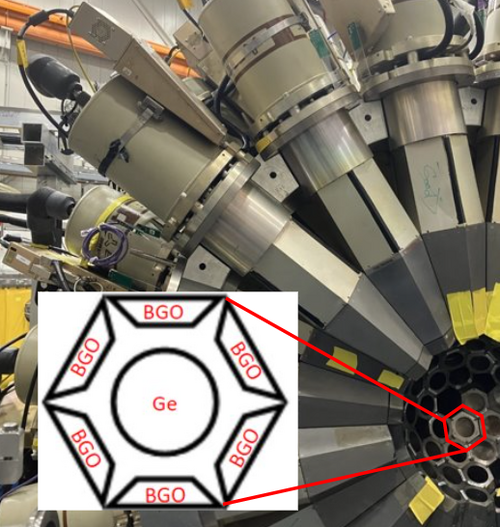High Purity Germanium (HPGe) and BGO: Difference between revisions
No edit summary |
No edit summary |
||
| (4 intermediate revisions by the same user not shown) | |||
| Line 1: | Line 1: | ||
<imagemap> | |||
Gammasphere's detectors use high purity germanium in order to increase a detector's probability of gamma ray interaction. | Image:LabeledDetector.png|500px|thumb|Figure 1. A closeup of BGO and HPGe in a detector. | ||
poly 66 150 128 80 374 286 445 365 424 393 170 226 [[Gammasphere Detectors]] | |||
</imagemap> | |||
Gammasphere's detectors use high purity germanium in order to increase a detector's probability of gamma-ray interaction. BGO (Bismuth Germanate) detectors surround each Ge Detector in Gammasphere to help with Compton scattering suppression. They form a hexagonal shape around the cylindrical Ge, and have an additional BGO "backplug", meaning each detector has 7 BGO contacts. Each detector produces ten different [[Detector Signals|signals]] for the [[DAQ system]] known as the GeCenter, GeSide and 7 BGO signals, which are compacted by the analog pre-processing into four differential signals (GeCenter, GeSide, BGOSum & BGOPattern). Note that in figure 1, the actual outer portion of the detector has sides that are made up of a metal called hevimets, which are dense materials that form a shield around the Ge at a detector's point. The hexagonal closeup in the diagram shows the arrangement of Ge and BGO inside the detector. | |||
''Go back to [[Gammasphere Detectors]]'' | |||
Latest revision as of 19:25, March 6, 2023
Gammasphere's detectors use high purity germanium in order to increase a detector's probability of gamma-ray interaction. BGO (Bismuth Germanate) detectors surround each Ge Detector in Gammasphere to help with Compton scattering suppression. They form a hexagonal shape around the cylindrical Ge, and have an additional BGO "backplug", meaning each detector has 7 BGO contacts. Each detector produces ten different signals for the DAQ system known as the GeCenter, GeSide and 7 BGO signals, which are compacted by the analog pre-processing into four differential signals (GeCenter, GeSide, BGOSum & BGOPattern). Note that in figure 1, the actual outer portion of the detector has sides that are made up of a metal called hevimets, which are dense materials that form a shield around the Ge at a detector's point. The hexagonal closeup in the diagram shows the arrangement of Ge and BGO inside the detector.
Go back to Gammasphere Detectors
